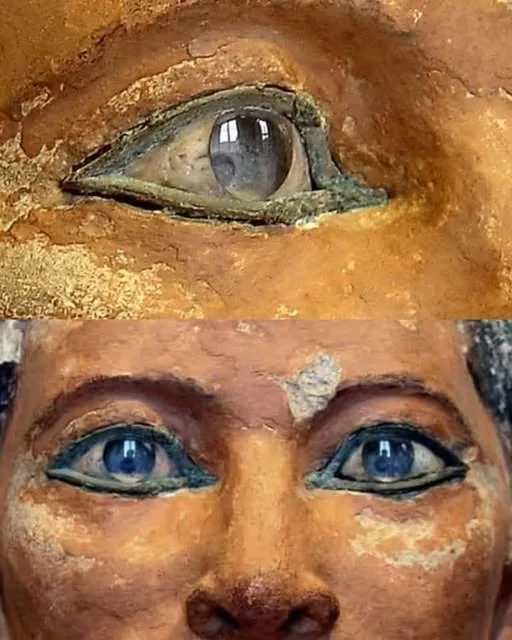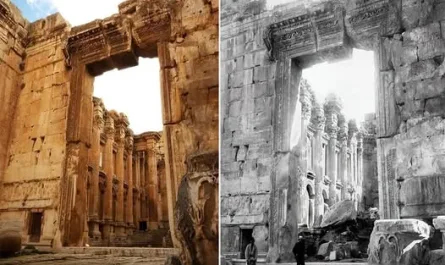The Seated Scribe, an iconic piece of ancient Egyptian art dating back to the Old Kingdom (circa 2600-2350 BCE), stands as one of the finest examples of Egyptian sculpture. While much of its allure lies in its realistic portrayal of a scribe in mid-action, one of its most remarkable features is the inlaid eye. Crafted from red-veined white magnesite and rock crystal, the eye is an extraordinary example of the intricate artistry and technical prowess achieved by ancient Egyptian craftsmen. This detailed feature not only enhances the lifelike quality of the figure but also offers a glimpse into the sophisticated artistic methods employed by ancient Egyptian sculptors.

The Seated Scribe: A Snapshot of Ancient Egyptian Society
The Seated Scribe is a portrayal of a middle-aged man, likely a government official or a private scribe, engaged in the act of writing. Unlike the idealized figures of pharaohs and gods seen in many Egyptian artworks, the Seated Scribe is refreshingly realistic. His body is plump, his face marked by wrinkles and a slightly tired expression. This attention to realism reflects the importance of the scribe’s role in Egyptian society. Scribes were vital to the administration, responsible for recording laws, religious texts, and the deeds of the pharaohs. They were often depicted in a more humanized manner, embodying the wisdom, intelligence, and practical skill that they were admired for, rather than the divine or heroic traits typically assigned to the upper echelons of society.
The Eye: An Inlaid Work of Art
What truly sets the Seated Scribe apart, however, is the detail of his eyes. The eyes of the sculpture are not simple carvings; they are inlaid with materials that would have been precious and difficult to obtain at the time, demonstrating the technical skill of the artist. The inlaid eyes are composed of two primary materials: red-veined white magnesite for the sclera (the white part of the eye) and rock crystal for the cornea. These materials, particularly magnesite, were not native to Egypt, suggesting that they were imported, highlighting the trade networks that the ancient Egyptians maintained. The use of such materials would have been a sign of wealth and status, indicating that the scribe was a person of considerable importance.
The rock crystal was finely polished to create a smooth, translucent surface that mimicked the natural appearance of an eyeball. The magnesite, with its distinctive red veins, was carefully selected to give the sclera an appearance of life and depth. The eyes were further detailed by adding a colored material to represent the iris, which was fixed behind the polished crystal. This artistic technique enhanced the lifelike quality of the sculpture and contributed to the overall sense of realism that the piece exudes. The irises were likely created using a combination of natural pigments and resins, materials readily available in Egypt. This intricate level of detail in the eyes, where even the iris is carefully represented, would have made the sculpture appear almost alive.
Symbolism of the Eyes in Ancient Egyptian Art
In ancient Egyptian culture, the eyes were a symbol of perception, wisdom, and clarity. The concept of “seeing” was deeply symbolic, representing not only physical vision but also the ability to discern spiritual truths. The use of inlaid eyes in sculptures was not limited to realism; it also conveyed an important symbolic message. The eye was seen as a conduit to the soul, and the act of giving an image or statue eyes was thought to animate the figure. This belief stemmed from the idea that a person’s soul could continue to exist in the afterlife, and the eyes would allow the spirit to see and interact with the world. Therefore, the meticulous crafting of the eyes in the Seated Scribe may have been an effort to ensure that the figure would possess the necessary faculties to “see” into the afterlife, making the scribe’s soul capable of enduring beyond death.
Moreover, the eyes were not only symbolic of the spirit’s perception but also served as a reflection of the vitality of the individual depicted. In the case of the Seated Scribe, the eyes could be interpreted as reinforcing the active, engaged nature of the figure, who is immersed in his work and in the practice of recording knowledge. By adding such lifelike eyes, the sculptor ensured that the scribe was portrayed as a vibrant, thinking individual, contributing to the broader theme of the artwork: the importance of intellect, wisdom, and the written word in Egyptian society.
A Reflection of Egyptian Craftsmanship and Trade
The skill required to create the inlaid eyes of the Seated Scribe speaks volumes about the level of craftsmanship in ancient Egypt. Not only was the artist proficient in the use of stone and crystal, but the choice of materials indicates a deep understanding of texture, color, and the ability to manipulate different substances to achieve a desired effect. The polished crystal, in particular, would have required great precision to avoid cracking or damaging the delicate material. Similarly, the red-veined magnesite, with its subtle hues, was carefully chosen to add a layer of depth to the figure, drawing attention to the realism of the face.
The use of imported materials such as magnesite also reflects the interconnected nature of the ancient Egyptian world. Egypt was part of a complex network of trade routes that spanned Africa and the Near East, providing access to rare materials that could not be found locally. The existence of such trade, evident in the Seated Scribe’s eyes, underscores the Egyptian Empire’s economic and cultural reach during the Old Kingdom.
Conclusion
The inlaid eyes of the Seated Scribe are a stunning testament to the artistry, symbolism, and technical skill of ancient Egyptian craftsmen. Through the use of red-veined white magnesite, rock crystal, and other materials, the artist imbued the sculpture with a lifelike presence that transcends the boundaries of time. The eyes are not just a marvel of ancient craftsmanship but also a powerful symbol of perception, wisdom, and the eternal connection between life and the afterlife. As we look at the Seated Scribe today, we are reminded of the enduring legacy of ancient Egyptian culture and the extraordinary skill of its artists, who were able to capture the essence of life in stone and crystal.





